Abstract
The direct C–H multifunctionalization of quinoxalin-2(1H)-ones via multicomponent reactions has attracted considerable interest due to their diverse biological activities and chemical profile. This review will focus on recent achievements. It mainly covers reaction methods for the simultaneous introduction of C–C bonds and C–RF/C/O/N/Cl/S/D bonds into quinoxalin-2(1H)-ones and their reaction mechanisms. Meanwhile, future developments of multi-component reactions of quinoxalin-2(1H)-ones are envisaged, such as the simultaneous construction of C–C and C–B/SI/P/F/I/SE bonds through multi-component reactions; the construction of fused ring and macrocyclic compounds; asymmetric synthesis; green chemistry; bionic structures and other fields. The aim is to enrich the methods for the reaction of quinoxalin-2(1H)-ones at the C3 position, which have rich applications in materials chemistry and pharmaceutical pharmacology.
1. Introduction
In multi-component reactions (MCRs), three or more substrate molecules are transformed in a single pot to produce the desired product. In some cases, they are also referred to as multi-component assembly processes (MCAPs). Through MCRs, a large number of organic compounds can be synthesized in an efficient and atom-economic manner, with little waste and no hazardous substances, and with high yields of final products [1,2,3]. MCRs were first proposed by Strecker in 1850 for the synthesis of α-amino nitriles from ammonia, carbonyl compounds and hydrogen cyanide [4,5,6,7]. Subsequently, more and more researchers have become interested in this approach, as this multiple bonding route involving C–C and C–heteroatom bond formation can be used to prepare a variety of heterocyclic compounds with combinatorial, medicinal and agricultural chemistry applications [8,9]. In recent years, multicomponent reactions using quinoxalin-2(1H)-ones as a substrate have gained increasing interest (Scheme 1). A range of ingenious and innovative methods have been developed to offer prosperous prospects for this highly applicable compound.
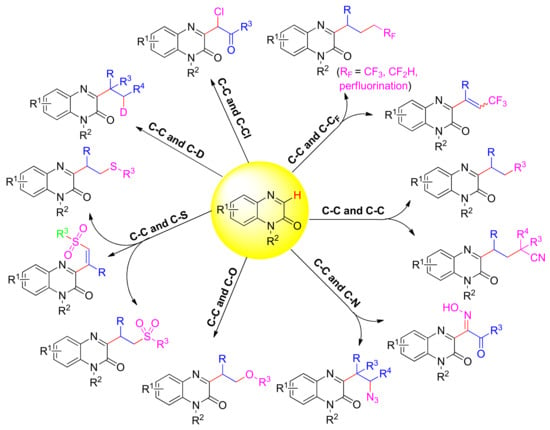
Scheme 1.
Direct C–H functionalization of quinoxalin-2(1H)-ones via multi-component tandem reactions.
Quinoxalin-2(1H)-ones have been considered as a specific class of heterocyclic structural groups existing in a diverse range of biologically active natural products and pharmaceutical compounds [10,11,12]. Furthermore, the quinoxalin-2(1H)-one fragment is a promising electron-withdrawing substituent for the development of push-pull systems with promising photophysical properties for various applications in material science [13,14]. In particular, the C3-substituted quinoxalin-2(1H)-one derivatives show a broad range of biological activities (Scheme 2) [15,16,17,18,19,20,21,22,23,24]. The direct C–H functionalization of quinoxalin-2(1H)-ones at the C3 position is the most cost-effective way to synthesize a wide range of quinoxalin-2(1H)-one derivatives containing valuable functional groups. In recent years, quinoxalin-2(1H)-one has been prominently studied [15,16,17,18,19,20,21,22,23,24]. Furthermore, the direct acid-catalyzed C–H bond functionalization of quinoxalin-2(1H)-one based on a nucleophilic aromatic substituted hydrogen approach (SNH-reaction) is of equal interest [25,26,27,28,29]. Several reviews summarize the C-3 functionalization of quinoxalin-2(1H)-one and were published between 2019 and 2021 [15,16,17,18,19,20,21,22,23,24]. However, there are no reviews discussing the topical issue of the C–H functionalization of quinoxalin-2(1H)-one via multicomponent reactions. Our group has also conducted some studies on the functionalization of quinoxalin-2(1H)-one at the C3 position [30,31,32]. Therefore, a review is necessary in order to better develop the functionalization of quinoxalin-2(1H)-one at the C3 position via a multi-component tandem approach. This review focuses on the C–H functionalization of quinoxalin-2(1H)-one by multi-component tandem reaction methods in recent years and demonstrates the corresponding reaction mechanisms. We classify them according to the different chemical bonds formed and the simultaneous construction of both C–C and C–RF/C/O/N/Cl/S/D bonds via multi-component tandem reactions.
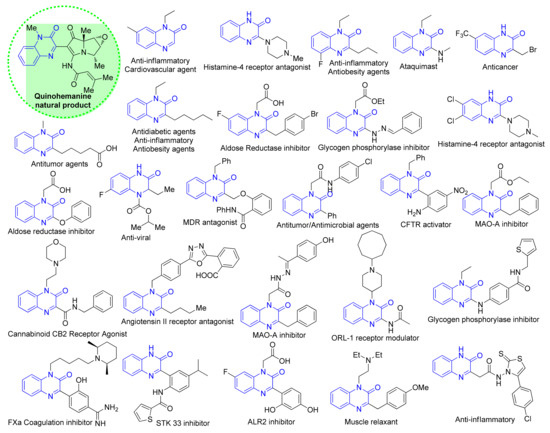
Scheme 2.
C-3 substituted bio-active quinoxalin-2(1H)-ones derivatives.
2. Direct C–H Functionalization of Quinoxalin-2(1H)-Ones via Multi-Component Tandem Reactions
2.1. Simultaneous Construction of Both C–C and C–RF Bonds via Multi-Component Tandem Reactions
Organic fluorides are widely found in pharmaceuticals, agrochemistry, and materials science. The introduction of fluorine atoms into the organic framework not only produces profound changes in the physical and chemical properties of the target molecules, but also has special biological properties [33]. During the direct C–H bifunctionalization of quinoxalin-2(1H)-ones through multi-component tandem reactions, it is possible to construct bonds C–C bonds and C–RF bonds in a single step. Recently reported reactions include trifluoroalkylation, difluoroalkylation and perfluoroalkylation.
2.1.1. Trifluoroalkylation
In 2020, Wei et al. [34] reported a simple and efficient three-component protocol for the construction of various 3-trifluoroalkylquinoxalin-2(1H)-ones via K2S2O8-mediated difunctionalization of unactivated alkenes with quinoxalin-2(1H)-ones and CF3SO2Na under metal-free conditions (Scheme 3). As soon as water was added to this reaction system, the reaction efficiency was evidently improved. The optimal reaction conditions were determined after screening a variety of oxidants and solvents. K2S2O8 proved to be the preferred oxidant, and a 4:1 ratio of CH3CN/H2O produced the highest quality product with 77% yield. Differently substituted quinoxalin-2(1H)-ones and unactivated alkenes were used to investigate substrate scope after the reaction conditions were established. Following a series of control experiments, the mechanism of the reaction was established. The addition of TEMPO resulted in the complete quenching of the reaction progress, confirming the presence of a radical mechanism. Furthermore, the radical addition product was detected by LC-MS when the radical capture reaction of ethene-1,1-diyldibenzene was conducted under standard conditions. As shown in Scheme 3, a possible reaction mechanism has been proposed. At the beginning, K2S2O8 was used to produce CF3 radical 1e. In subsequent steps, alkene 1b was selectively added to the CF3 radical to generate alkyl radical 1f. In turn, alkyl radical 1f added to quinoxalin-2(1H)-one 1a produced nitrogen radical 1g. Then, intermediate 1g was further oxidized by K2S2O8 to give a nitrogen cation intermediate 1h. Finally, the desired product 1d was obtained by the deprotonation of intermediate 1h.
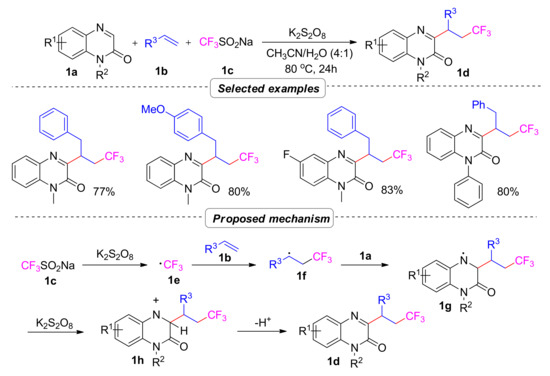
Scheme 3.
Trifluoroalkylation of quinoxalin-2(1H)-ones with unactivated alkenes.
In 2020, Li et al. [35] also used CF3SO2Na, unactivated alkenes and quinoxalin-2(1H)-ones to complete a three-component reaction (Scheme 4). The difference was the use of PhI(OAc)2 as the oxidant and ethyl acetate as the solvent. A variety of different unactivated alkenes and quinoxalin-2(1H)-ones are suitable for this reaction method. Maximum yields of 80% were achieved. The reaction mechanism was also found to be a free radical mechanism after controlled experiments, which is basically consistent with the reaction mechanism reported by Wei’s group (Scheme 4).

Scheme 4.
Trifluoroalkylation of quinoxalin-2(1H)-ones with unactivated alkenes.
In the same year, Huang et al. [36] reported an unexpected three-component reaction of quinoxalin-2(1H)-one, tert-butyl peroxybenzoate (TBPB) and hexafluoroisopropanol (HFIP) (Scheme 5). A variety of hydroxyhexafluoroisobutylated quinoxalin-2(1H)-ones were formed under CuBr-catalyzed and TBPB-oxidized conditions. In screening the reaction conditions, the addition of K2CO3 resulted in a significant increase in yield. The range of substrates was extended with a maximum isolated yield of 72%. The methylene in the product was deduced from TBPB, and the reaction mechanism was proposed after controlled experiments and literature reports. TBPB was reduced by Cu(I) to produce the tert-butoxy radical. β-Scission of the tert-butoxy radical yielded acetone and a methyl radical, which was then added to quinoxalin-2(1H)-one 3a to form the radical intermediate 3e. On the other hand, a two-step hydrogen atom transfer (HAT) from HFIP to methyl generated hexafluoroacetone. Finally, the nucleophilic addition of 3f and hexafluoroacetone produced product 3d (Scheme 5).
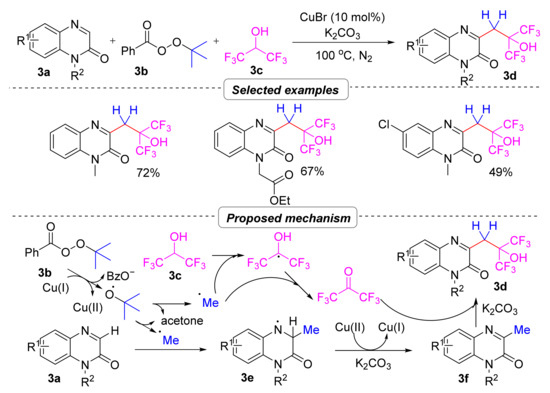
Scheme 5.
C–H functionalization of quinoxalin-2(1H)-ones with hexafluoroisopropanol.
In the year 2021, Wei’s group [37] reported different photocatalytic methods for the same reaction (Scheme 6). They have developed a facile and efficient visible-light-induced three-component reaction of quinoxalin-2(1H)-ones, alkenes and CF3SO2Na, leading to various 3-trifluoroalkylated quinoxalin-2(1H)-ones at room temperature. The present photocatalytic tandem reaction, which utilizes 4CzIPN (1,2,3,5-tetrakis(carbazol-9-yl)-4,6-dicyanobenzene) as the photocatalyst and air as the green oxidant, offers a mild and environmentally friendly protocol to access a number of 3-trifluoroalkylated quinoxalin-2(1H)-ones in moderate to favorable yields. Through this methodology, various 3-trifluoroalkylated quinoxalin-2(1H)-ones could be obtained in moderate to high yields from simple and readily available materials in the absence of any strong external oxidant. Following a series of control experiments, the mechanism of the reaction was established. Moreover, Stern–Volmer quenching experiments were conducted to prove an energy transfer process between 4CzIPN and substrates under visible-light irradiation. As shown in Scheme 6, a possible reaction pathway was proposed. In the first step, 4CzIPN* was excited from 4CzIPN by visible-light irradiation. Afterwards, 4CzIPN•− and radical cation 4e were produced by a single electron transfer (SET) from 4a to the excited state of 4CzIPN*. 4CzIPN•− was oxidized by dioxygen to give the ground state 4CzIPN and O2•−. At the same time, CF3SO2Na 4c was oxidized by O2 (air) to produce the O-centered radical 4f. Radical 4f underwent self-induced loss reduction in SO2 to give CF3 radical 4g. Subsequently, 4g was added to the olefin 4b to form the alkyl radical 4h, which attacked the radical cation 4e and formed a nitrogen cation 4i. Lastly, the deprotonation of 4i produced the desired product 4d.
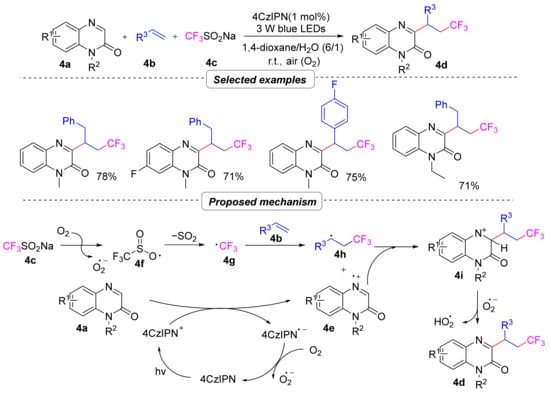
Scheme 6.
Visible-light-induced trifluoroalkylated quinoxalin-2(1H)-ones.
In the same year, the Huang team [38] reported a three-component tandem reaction for the photocatalytic bifunctionalization of olefins using quinoxalin-2(1H)-ones and ICH2CF3/ICH2CF2H as feedstocks and Ir(ppy)2(dtbbpy)PF6 (ppy = 2-phenylpyridine, dtbbpy = 4,4′-di-tert-butyl-2,2′-bipyridine) as catalyst. (Scheme 7). Various trifluoroacetylated and difluoroacetylated quinoxalin-2(1H)-ones were synthesized. In the substrate extension, the highest yield of the three-component reaction of trifluoroethylated quinoxalin-2(1H)-ones reached 77%, and the highest yield of the three-component reaction of difluoroethyl quinoxalin-2(1H)-ones reached 74%. After controlled experiments and literature analysis, they suggested that the mechanism of this three-component reaction might be a free radical cascade reaction, but no reaction details were given.
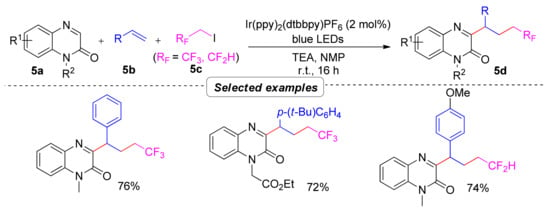
Scheme 7.
Photoredox-catalyzed trifluoroethylation and difluoroethylation.
Graphene oxide (GO) has an abundance of defects and a wide range of oxygen functional groups that can be used in organocatalytic reactions. In 2021, Liu et al. [39] proposed a three-component tandem reaction using GO as a catalyst and CF3SO2Na as a powerful CF3 radical source to form olefinic C–CF3 with quinoxalin-2(1H)-ones and alkynes, resulting in a series of E/Z isomeric mixed 3-trifluoroalkyl quinoxalin-2(1H)-ones. Based on mechanistic studies, GO is capable of auto-tandem radical addition to trifluoromethyl and superoxide radicals (Scheme 8).
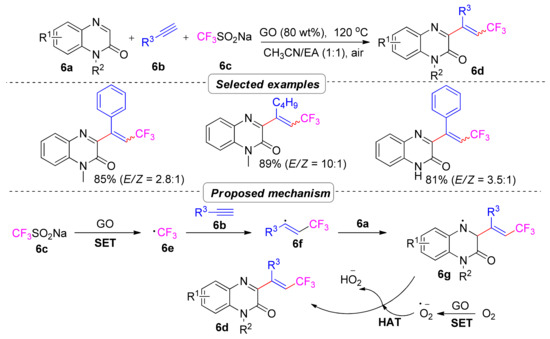
Scheme 8.
Graphene oxide-catalyzed trifluoromethylation.
In 2022, Shen et al. [40] developed a three-component reaction consisting of indole, quinoxalin-2(1H)-one and CF3SO2Na, using CuF2 as a catalyst and K2S2O8 as an oxidant, to easily obtain various 3-[2-(trifluoromethyl)1H-indol-3-yl]quinoxalin-2(1H)-ones (Scheme 9). The strategy exhibited high site selectivity, step economy and a wide range of substrates. A possible reaction mechanism was suggested in Scheme 9. A weak coordination between Cu(II)Ln species and the nitrogen atom of quinoxalin-2(1H)-one led to the generation of 7e. By oxidative dehydrogenation, 7e reacted with 7b to form 7f, which was then converted to 7h. In addition, Cu(I)Ln was oxidized by K2S2O8 to Cu(II)Ln. By weak coordination of Cu(II)Ln species with the carbonyl group of the quinoxalin-2(1H)-one motif, 7h combined with Cu(II)Ln to produce complex 7i. As a result of the oxidation of CF3SO2Na and K2S2O8, a trifluoromethyl radical was generated. Then, the indole ring of complex 7i was attacked by a CF3· to produce 7j, which was transformed into intermediate 7k through the single electron transfer (SET) process. Thereafter, the oxidation of 7k occurred, leading to compound 7l by oxidation. Eventually, the target product 7d was obtained by the deprotonation of 7l with the regeneration of Cu(II)Ln.

Scheme 9.
Copper-catalyzed multicomponent reaction to construct fluorinated indole-quinoxalin-2(1H)-ones.
2.1.2. Perfluoroalkyl
In 2019, Studer et al. [41] described the reaction of α-perfluoroalkyl-β-heteroaryl groups with perfluoroalkyl iodides and quinoxalin-2(1H)-ones on various alkenes initiated under visible light (Scheme 10). This three-component free radical cascade reaction allowed the efficient synthesis of a series of quinoxalin-2(1H)-one derivatives containing perfluoroalkyl groups in moderate to excellent yields under mild conditions. The reactions proceed through acidic amino radicals that are readily deprotonated to give the corresponding radical anions capable of maintaining the radical chains. The radical chains act as reducing reagents for single electron transfer (Scheme 10).
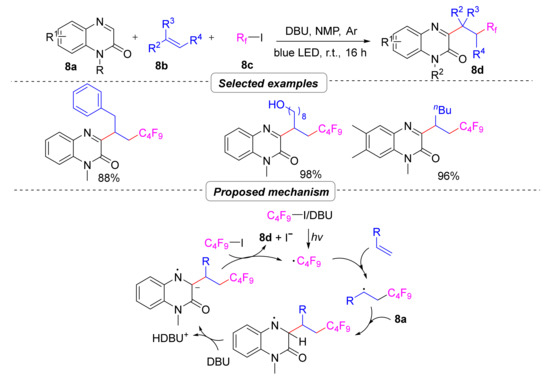
Scheme 10.
Photoinitiated three-component α-perfluoroalkyl-β-heteroarylation of unactivated alkenes.
2.1.3. Difluoroalkylation
In 2022, Lu et al. [42] published a photocatalytic three-component reaction consisting of quinoxalin-2(1H)-ones, alkenes and hypervalent iodine(III) reagents (Scheme 11). They used an original difluoroiodine(III) reagent of their own design, showing high reactivity with [bis(trifluoroacetoxy)iodo]benzene (PIFA) as the oxidizing agent. Under mild conditions, a wide range of difluoroalkyl-substituted quinoxalin-2(1H)-ones can be obtained in up to 95% yield. The experimental mechanism suggests the involvement of a difluoroalkyl radical intermediate in this reaction (Scheme 11).
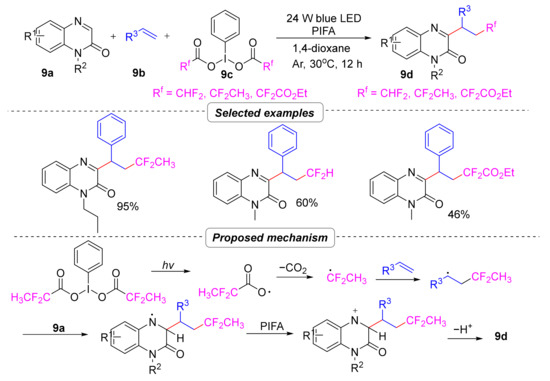
Scheme 11.
Photoinduced three-component difluoroalkylation of quinoxalin-2(1H)-ones.
In the same year, Li et al. [43] reported visible-light photoredox-catalyzed, unactivated olefin, quinoxalin-2(1H)-one and bromodifluorinated reagents involved in a three-component reaction via fac-Ir(ppy)3 catalysis (Scheme 12). The difluoroalkyl-containing quinoxalin-2(1H)-ones were synthesized by the single-step formation of two novel C–C bonds under mild reaction conditions. Three-component reactions showed high functional group compatibility and a wide range of substrates. Free radical processes may be responsible for this three-component transformation, according to preliminary mechanistic studies (Scheme 12).
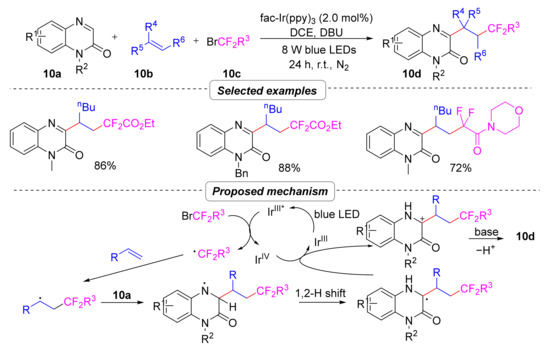
Scheme 12.
Visible-light photoredox-catalyzed three-component difluoromethylative quinoxalin-2(1H)-ones.
2.2. Simultaneous Construction of Double C–C Bonds via Multi-Component Tandem Reactions
The establishment of C–C bonds by direct C–H functional grouping is more atomically economical than the establishment of C–C bonds based on transition metal-catalyzed cross-coupling reactions of halogenated hydrocarbons [44].
2.2.1. Alkylation
In 2021, Yao et al. [45] described a metal-free catalytic, H2O2-mediated three-component reaction of quinoxalin-2(1H)-ones, DMSO and styrene. A series of 3-substituted quinoxalin-2(1H)-ones were synthesized using DMSO as the methylation reagent (Scheme 13). The reaction substrates were well tolerated and the products were obtained in moderate to acceptable yields, with the highest yields up to 86%. The reaction was shown to be a free radical reaction mechanism by controlled experiments. Initially, hydroxyl radicals were generated through the homolytic cleavage of H2O2 and subsequently reacted with DMSO to produce methyl radicals 11e. The methyl radical then selectively attacked styrene 11b, generating alkyl radical 11f. As a result of the addition of alkyl radical 11f to quinoxalin-2(1H)-one 11a, a nitrogen radical 11g was formed, which was then oxidized by H2O2, resulting in a nitrogen cation intermediate 11h. In the end, intermediate 11h was deprotonated to produce the desired product (Scheme 13).
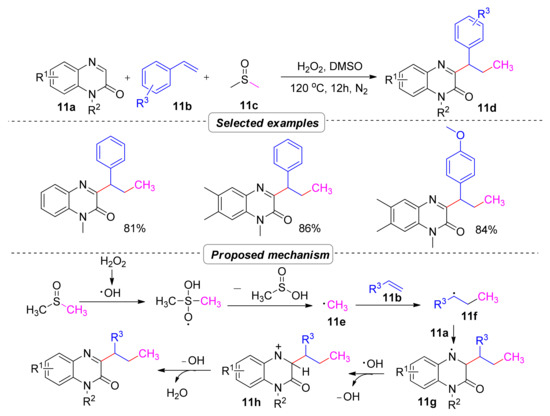
Scheme 13.
H2O2-promoted alkylation of quinoxalin-2(1H)-ones.
In 2022, Baishya et al. [46] reported a three-component reaction of quinoxalin-2(1H)-ones with 4-hydroxycoumarin/4-hydroxy-6-methyl-2-pyrone and aryl ethylene (Scheme 14). The 3-alkylquinoxalin-2(1H)-one was synthesized using K2S2O8 as the oxidant and DMSO as the solvent. During the optimization of the reaction conditions, the highest yield of the three-component product was only 44%. They performed substrate extensions with yields below 48%. The involvement of free radicals in the reaction process was demonstrated by controlled experiments. The reaction mechanism was essentially similar to the above reaction, with K2S2O8 initiating free radicals (Scheme 14).
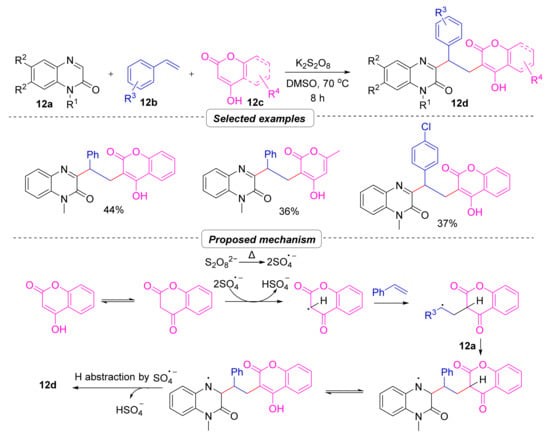
Scheme 14.
K2S2O8-mediated three-component radical cascade C3 alkylation of quinoxalin-2(1H)-ones.
2.2.2. Cyanoalkylation
In the same year, Baishya and his group [47] published a K2S2O8-mediated three-component reaction (Scheme 15). The reaction of quinoxalin-2(1H)-ones with azobis(alkylcarbonitrile)s and aryl ethylenes was used to synthesize 3-cyanoalkyl quinoxalin-2(1H)-ones. This scheme introduced cyano into quinoxalin-2(1H)-ones and is widely used in reasonable yields and acceptable functional group tolerances. The replacement of aryl ethylene with phenylacetylene is also applicable to this method. Controlling experimental and literature knowledge, they proposed a radical reaction mechanism similar to the above alkylation (Scheme 15). The reaction started by heating AIBN to form the 1,1-dimethyl-1-cyanomethyl radical 13e, which added to the terminal position of the olefin to give the secondary alkyl radical 13f. Then, 13f attacked the C3 position of the quinoxalin-2(1H)-one 13a to give the N-radical 13g which, after H-atom abstraction by the excess SO4•− present in the reaction medium, gave the three-component desired product 13d (pathway a). Again, 13g was deprotonated to form the radical anion 13h. Then, 13h reacted with persulphate via SET to give the desired product 13d (pathway b).
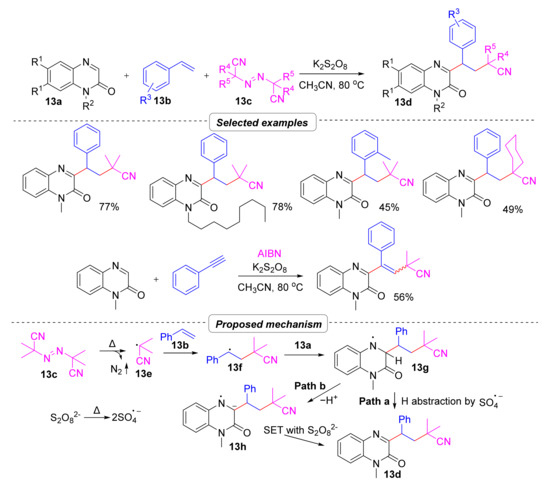
Scheme 15.
Cyanoalkylation of quinoxalin-2(1H)-ones with vinylarenes and azobis(alkylcarbonitrile)s.
2.3. Simultaneous Construction of Both C–C and C–O Bonds via Multi-Component Tandem Reactions
Ether functional groups constructed through C–C and C–O bonds are an essential structural characteristic of many natural products, pharmaceutical functional materials and agrochemicals [48].
In 2022, Yao et al. [49] implemented a simple strategy for the synthesis of 3-substituted quinoxalin-2(1H)-ones containing ether units via a three-component synthesis of quinoxalin-2(1H)-one, styrene, and tert-butyl peroxybenzoate (TBPB) using CuCl as a catalyst (Scheme 16). This method introduced both C–C and C–O bonds in the product with acceptable functional group tolerance. After controlled experiments, a reaction mechanism was proposed in Scheme 16. First, TBPB 14c was homolytically cleaved under heating conditions to produce benzoyloxy radicals (BzO·) and tert-butoxy radicals 14e. Simultaneously, Cu(I) was converted to Cu(II) and BzO− was converted to benzoyloxy anion (BzO−) due to electron transfer. At the same time, 14e selectively attacked styrene 14b, leading to the generation of alkyl radical 14f. Next, 14f was added to 14a to produce nitrogen radical 14g. Then, 14g provided the nitrogen cation 14h via Cu(II) single-electron oxidation. Finally, the expected coupling product 14d was provided by the deprotonation of 14h.
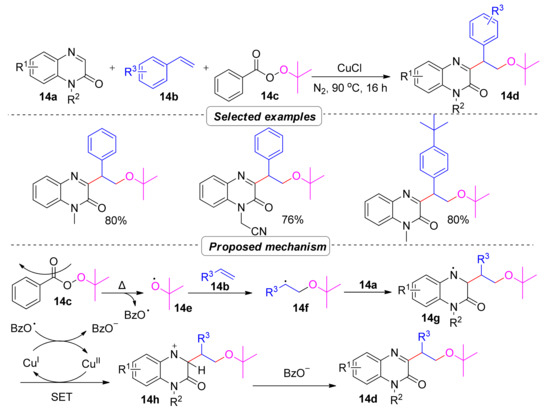
Scheme 16.
Alkylation of quinoxalin-2(1H)-ones with styrenes and tert-butyl peroxybenzoate.
In the same year, Wang et al. [50] reported the visible light-induced bifunctionalized three-component reaction of 2,3-dihydrofuran with quinoxalin-2(1H)-one and tert-butyl hydroperoxide (Scheme 17). They synthesized a series of 2,3-disubstituted tetrahydrofurans in high yields by simultaneously forming C–C and C–O bonds using 2,4,6-triphenylpyrylium tetrafluorborate (TPPT) as a photocatalyst. The multicomponent reactions exhibited excellent site-selectivity of carbon–carbon double bonds, superior functional group tolerance and high diastereoselectivity (d.r. > 99%). The mechanism was determined by controlled experiments and hydroxyl radical assay as a visible light-induced radical reaction (Scheme 17). First, the photocatalyst (PC+) was excited under visible light irradiation to generate the excited species (PC+*), which then underwent a single electron transfer (SET) process with substrate 15a to afford a radical cation intermediate 15e and a PC•. tert-Butyl hydroperoxide (TBHP) abstracted an electron from the obtained PC· to give a HO· radical, which could be detected by EPR, and a tBuO− together with the oxidation of PC• to PC+ for the catalytic cycle. On the other hand, A reacted with 2,3-dihydrofuran (15b) to give intermediate 15f, which was attacked by TBHP as a nucleophilic reagent to give intermediate 15g. In the presence of tBuO−, the deprotonation of 15g gave the intermediate 15h. Finally, 15h underwent SET oxidation and deprotonation to give the desired product 15d.
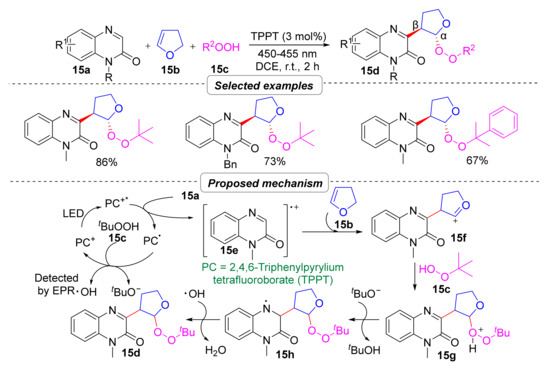
Scheme 17.
Visible-light-induced difunctionalization of 2,3-dihydrofuran.
2.4. Simultaneous Construction of Both C–C and C–N Bonds via Multi-Component Tandem Reactions
2.4.1. Azidoalkylation
It is highly attractive to synthesize organic azides by difunctionalizing alkenes, owing to the efficient and consecutive introduction of N3 and other functional groups [51]. Specifically, organic azides resulting from this process could undergo a variety of transformations and have a wide range of synthetic applications.
In 2019, Zhang et al. [51] reported for the first time a three-component tandem reaction of quinoxalin-2(1H)-ones with unactivated olefins and TMSN3 (Scheme 18). The reaction used a hypervalent iodine(III) reagent as an oxidant to synthesize a series of quinoxalin-2(1H)-ones containing azide groups. Remarkably, this was an efficient transformation accomplished within 1 min. Through controlled experiments, a single electron transfer (SET) mechanism was revealed in Scheme 18. Initially, TMSN3 was oxidized by PhI(TFA)2 to produce the azide radical 16e. The resulting 16e was then chemically selectively added to 16b to yield an alkyl radical 16f. Next, the addition of 16f to substrate 16a yielded the nitrogen radical intermediate 16g. Thereafter, 16g was converted to a carbon radical 16h via a 1,2-hydrogen transfer process. Then, 16h was further oxidized by PhI(TFA)2 to form a carbon cation intermediate 16i via another single electron transfer (SET) process. Lastly, the desired product 16d was provided by the deprotonation of 16i.
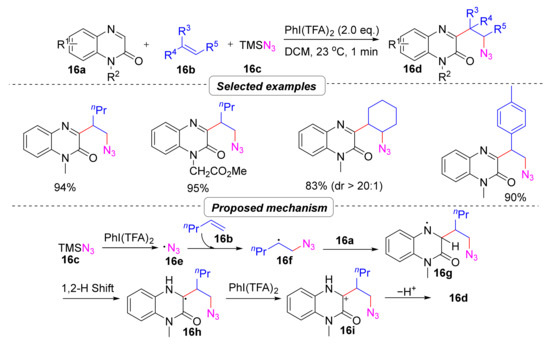
Scheme 18.
Three-component reaction of quinoxalin-2(1H)-ones with olefins and TMSN3.
In 2020, Qin et al. [52] published a cascade azidoalkylation reaction with a free radical mechanism (Scheme 19). This three-component reaction used PhI(OAc)2 as an oxidant to provide a valuable series of β-azidoalkylated quinoxalinones by coupling olefins, quinoxalin-2(1H)-ones, and TMSN3. Notably, the reaction was completely blocked when the base was removed from the reaction system. Why the presence of bases was indispensable was not answered by the authors. There was a puzzling result in contrast to Zhang’s study [51] where the same oxidant (PhI(OAc)2), solvent (MeCN) and temperature (r.t.) gave 0% yield while Zhang’s result was 52% yield. The only difference was that Zhang was an open bottle reaction and Qin was N2 protected. A free radical reaction mechanism similar to that described above was proposed by controlled experiments and previous reports (Scheme 19).
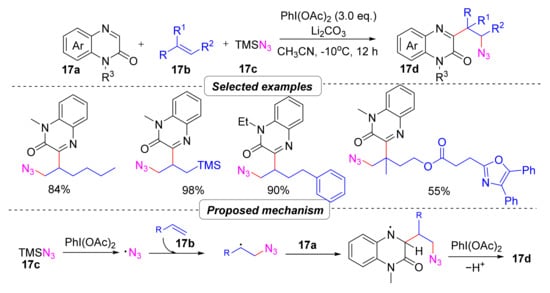
Scheme 19.
Three-component reaction of quinoxalin-2(1H)-ones with olefins and TMSN3.
In 2022, the same Zhang group [53] demonstrated a visible light-mediated three-component tandem reaction method using 9-mesityl-10-methylacridinium perchlorate (Acr+MesClO4−) as a photocatalyst for the reaction of N-heterocyclic aromatic hydrocarbons with unactivated olefins and TMSN3 (Scheme 20). This strategy achieved a room temperature conversion that was not achieved by previous authors and does not use a polyvalent iodine reagent. It is noteworthy that the reaction cannot be carried out under an N2 atmosphere. The method is very tolerant of functional groups and enables the synthesis of various heterocyclic olefins with medicinal value. The mechanism of the visible light-driven free machine reaction was proposed by controlled experiments. The overall process is consistent with the thermocatalytic reaction mechanism except that it starts with the photocatalytic initiation of the azide free machine and ends with O2·− deprotonation to obtain the product (Scheme 20).
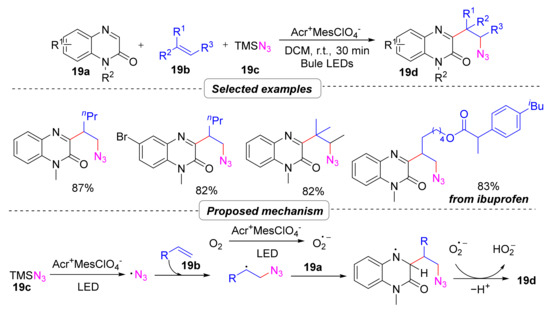
Scheme 20.
Photoinitiated multicomponent cascade reaction of N-heteroarenes.
2.4.2. Oxime
In 2021, Zhang et al. [54] developed a multicomponent reaction for the synthesis of (E)-quinoxalin-2(1H)-ones oximes (Scheme 21). The reaction consisted of quinoxalin-2(1H)-ones, ketone and tert-butyl nitrite (TBN) as three components. It should be noted that the reaction cannot be completed in the absence of CH3SO3 or under a N2 atmosphere. A variety of gram-level oxime-containing quinoxalin-2(1H)-ones were obtained by recrystallization. The reaction mechanism is proposed by controlled experiments in Scheme 21. Initially, the imino ion 18e was produced by the protonation of 18a. Simultaneously, acetone 18b was converted to the enol form 18f under acidic conditions. Next, A reacted with 18f to give 18h. Then, 18h was turned into 18i by an oxidative dehydrogenation process. Simultaneously, the homogeneous decomposition of TBN produced tert-butoxy (tBuO·) and nitroso (·NO) radicals. Subsequently, the nitroso (·NO) radical assaulted the C=C bond of 18i to give intermediate 18j, which then oxidized to intermediate 18k through tert-butoxy (tBuO·). Lastly, the goal product was produced by the isomerization of 18k.
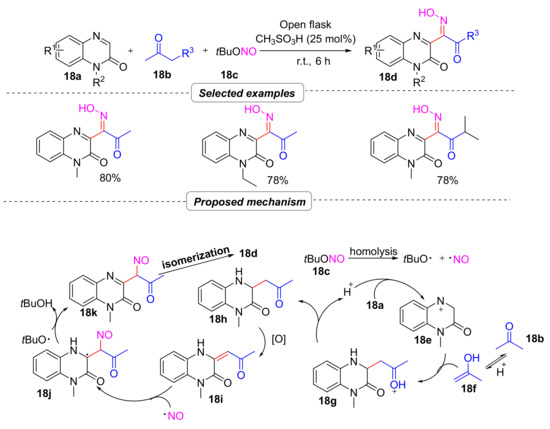
Scheme 21.
A multicomponent reaction for the synthesis of (E)-quinoxalin-2(1H)-ones oximes.
2.5. Simultaneous Construction of Both C–C and C–Cl Bonds via Multi-Component Tandem Reactions
In 2021, Zhang’s group [55] published the second three-component reaction on quinoxalin-2(1H)-ones (Scheme 22). A novel clean green multicomponent transformation of methyl ketones with α-bifunctionalization was achieved by a homogeneous ion-exchange resin Amberlyst 15 catalyst and sunlight catalysis. The reaction was carried out in water and air. Quinoxalinones containing both chloro- and keto-functional groups were obtained in moderate to acceptable yields. A similar reaction mechanism to that previously reported in Scheme 21 was proposed through a series of controlled experiments.
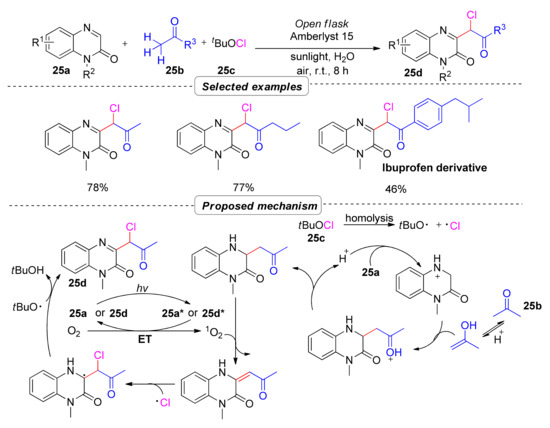
Scheme 22.
Multicomponent transformation of methyl ketones with α-bifunctionalization.
2.6. Simultaneous Construction of Both C–C and C–S Bonds via Multi-Component Tandem Reactions
Chemicals and physiologists are very interested in sulfur-containing compounds since they play an instrumental role in drug discovery and structural modification. Sulfones can not only act as wonderful pharmaceuticals, such as anticancers, antioxidants, and antifungals, but also serve as significant precursors for the synthesis of Sulphonic acids, sulfoxides, sulfanilamides and thioethers [56].
2.6.1. Sulfonyl Hydroxylation
In 2019, Koley et al. [57] proposed a three-component radical cascade reaction using TBHP as oxidant for the synthesis of α-sulfonyl-β-heteroaryl scaffolds using olefins, aryl sulfites and quinoxalin-2(1H)-ones (Scheme 23). When screening the reaction conditions, oxygen was found to be unfavorable for the reaction. A series of quinoxalin-2(1H)-ones containing sulfonyl groups were synthesized with high yields and functional group tolerance. A free radical reaction mechanism was postulated by controlled experiments (Scheme 23).
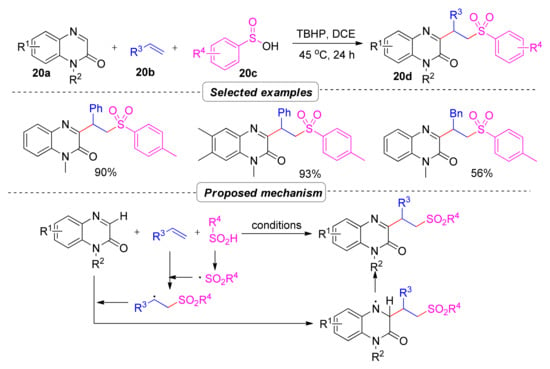
Scheme 23.
The synthesis of α-sulfonyl-β-heteroaryl scaffolds.
In 2020, Lee et al. [58] reported a stereoselective synthesis of various functionalized vinyl sulfones via a three-component vinyl sulfonation reaction of quinoxalin-2(1H)-ones, terminal alkynes and sulfonyl hydrazides under copper catalysis and TBHP oxidation. (Scheme 24). The reaction had a vast range of substrates. In the absence of a catalyst, this reaction could not proceed. Preliminary studies suggest that the reaction was a single electron transfer (SET) reaction mechanism. Sulfonyl hydrazide can be used as a source of sulfonyl radicals, which form through the interaction between Cu(II) and TBHP (Scheme 24).
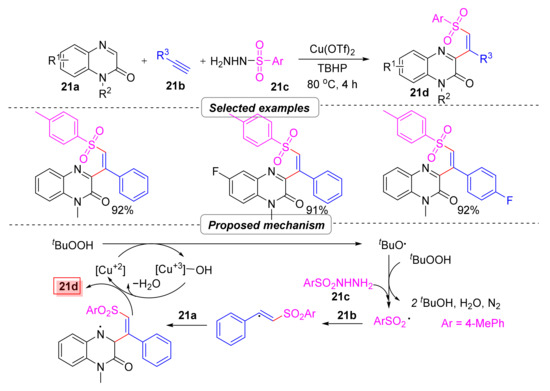
Scheme 24.
A three-component vinyl sulfonation reaction of quinoxalin-2(1H)-ones.
In 2021, He’s group [59] proposed a visible-light photocatalytic four-component sulfur dioxide insertion reaction using Rhodamine 6G as a catalyst to synthesize a series of vinyl sulfone-containing quinoxalin-2(1H)-ones from alkynes, sodium metabisulfite, aryldiazonium and quinoxalin-2(1H)-ones (Scheme 25). Both C–C bonds and C–S bonds could be constructed in a single operation. By comparing NMR spectra, the vinyl sulfone product was determined to be in the Z-configuration, with only trace amounts of isomers in the E-configuration (Z/E > 30/1). A possible mechanism for visible light-induced reactions is proposed in Scheme 25. In the same year, their group [60] proposed a similar visible-light photocatalytic four-component sulfur dioxide insertion reaction. The difference is that alkynes are replaced with alkenes.
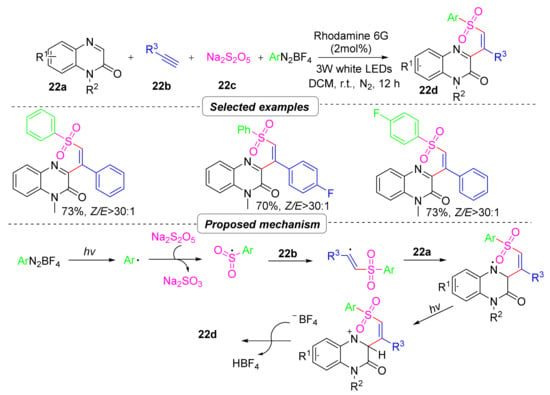
Scheme 25.
Visible-light photocatalytic four-component sulfur dioxide insertion reaction.
In 2021, Jiang et al. [56] published a direct bifunctionalized three-component cascade reaction of olefins with quinoxalin-2(1H)-one and sodium sulfonate using potassium persulfate (K2S2O8) as an oxidant to obtain a series of sulfone derivatives (Scheme 26). This method used only environmentally friendly water as the reaction solvent. A free radical reaction mechanism similar to such reactions was proposed by controlled experiments (Scheme 26). Initially, sodium sulfonates were converted to the corresponding radicals (22e) by the oxidation of K2S2O8. Subsequently, a radical addition of a sulfone radical via the C=C bond of alkenes was a critical step and led to the formation of the alkyl radical intermediate 22f. The active alkyl radical species 22f then reacted with quinoxalinones (22a) by addition at the most electrophilic C3 position to give the nitrogen radical species (22g), which rapidly underwent further dehydrogenation/oxidation by potassium persulfate to give the bifunctional sulfone derivatives (22d).
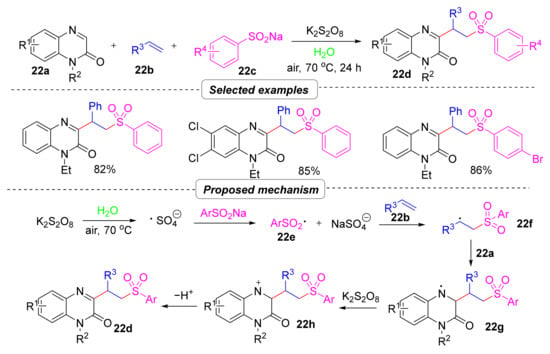
Scheme 26.
Three-component reaction of olefins with quinoxalin-2(1H)-one and sodium sulfonate.
In 2022, Wei’s group [61] reported the photocatalytic three-component tandem reaction of quinoxalin-2(1H)-ones, alkenes, and sulfites (Scheme 27). Using 4CzIPN as the catalyst and oxygen (air) as the oxidant, the tandem reaction prepared a series of sulfonated quinoxalin-2(1H)-ones. Free radical trapping experiments and fluorescence quenching experiments elucidated the visible light-mediated free radical reaction process (Scheme 27).
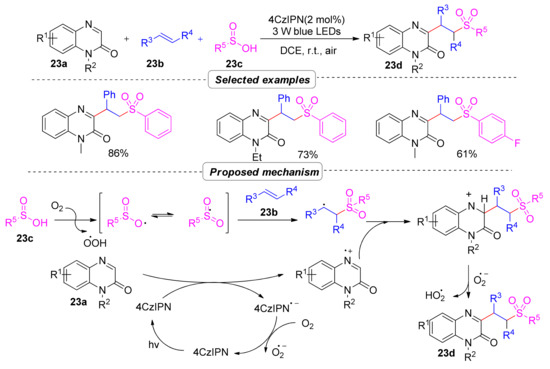
Scheme 27.
Photocatalytic three-component tandem reaction of quinoxalin-2(1H)-ones.
2.6.2. Thioalkylation
In the same year, Roy et al. [62] first developed an efficient and environmentally friendly three-component cascade reaction for the thioalkylation of quinoxalin-2(1H)-ones with olefins and aryl disulfides under visible light in the presence of no catalyst (Scheme 28). It is worth noting that oxygen is very detrimental to product generation. A series of sulfur-containing quinoxalin-2(1H)-ones were synthesized with excellent functional group tolerance and broad substrate suitability. This approach is also applicable to phenylacetylene instead of olefins. Mechanistic studies suggest that a major pathway is the involvement of quinoxalin-2(1H)-ones in the reaction as photosensitizers.
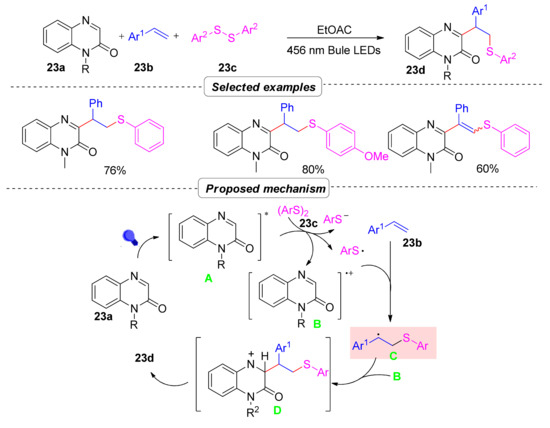
Scheme 28.
Three-component reaction for the thioalkylation of quinoxalin-2(1H)-ones.
2.7. Simultaneous Construction of Both C–C and C–D Bonds via Multi-Component Tandem Reactions
In 2020, Li et al. [63] first reported a fast three-component deuterated quinoxalin-2(1H)-ones reaction promoted by Fe(III) with alkenes and NaBD4 (Scheme 29). A series of deuterated quinoxalin-2(1H)-ones were synthesized with moderate to high yields. Through controlled experiments, they proposed a free radical reaction mechanism similar to that of other three-component reactions (Scheme 29).
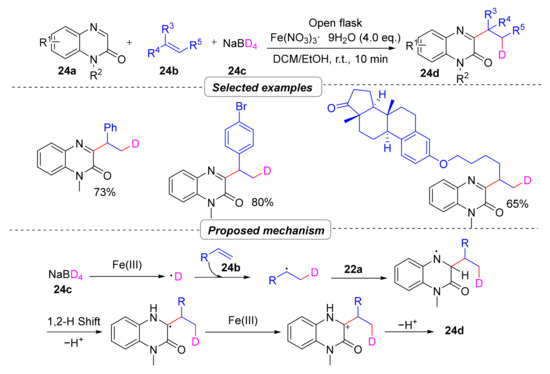
Scheme 29.
Three-component deuterated quinoxalin-2(1H)-ones reaction promoted by Fe(III) with alkenes and NaBD4.
3. Summary and Outlook
The direct C–H functionalization of quinoxalin-2(1H)-ones via multicomponent reactions allows the one-pot introduction of diverse functional groups, a facile and efficient method that has attracted increasing interest from synthetic chemists and which holds broad promise for medicinal chemistry and functional materials. In this review, we provide an overview of the C–H functionalization of quinoxalin-2(1H)-ones at the C3 position via multi-component reactions that have been reported in recent years in terms of the different categories of bond formation, and show the mechanisms of reactions that are mostly radical-based in order to provide a more in-depth and rapid understanding of the reactions. In addition, a number of meaningful functional groups commonly found in drugs such as trifluoromethyl, difluoromethyl, perfluoromethyl, alkyl, cyano, oxime, azide, alkoxy, sulfonyl, sulfur, deuterium and chloride are introduced into these quinoxalin-2(1H)-ones are summarized.
Despite these outstanding achievements, relatively few multicomponent reactions of quinoxalin-2(1H)-ones have been reported, and further work on the development of multicomponent reactions of quinoxalin-2(1H)-ones is essential. Firstly, the multicomponent reactions of quinoxalin-2(1H)-ones have not yet involved the simultaneous construction of C–C bonds and C–B/SI/P/F/I/SE bonds. In particular, the C–B/F/I/SE bond at the C3 position of quinoxalin-2(1H)-ones, which has not yet been completed, is expected to be completed by the multicomponent reactions of quinoxalin-2(1H)-ones. Secondly, the construction of fused ring and macrocyclic compounds by multicomponent reactions of quinoxalin-2(1H)-ones is also unexplored. Thirdly, asymmetric synthesis is a constant topic of research in organic methodology and the direct completion of asymmetric catalytic reactions at the C3 position of quinoxalin-2(1H)-ones is challenging, whereas the introduction of chiral centers via multicomponent reactions of quinoxalin-2(1H)-ones is a concise route. Fourthly, from the perspective of green chemistry, both photocatalysis and non-homogeneous catalysts that can be recycled are indispensable for the development of multi-component reactions of quinoxalin-2(1H)-ones. Fifthly, the parent nucleus structure of quinoxalin-2(1H)-ones is present in the metabolites of Streptomyces [64] (Scheme 2), and it is necessary to investigate the mimetic structure through the multicomponent reactions of quinoxalin-2(1H)-ones. In conclusion, we hope that this review will be useful for research in this field. The multicomponent reactions of quinoxalin-2(1H)-ones offer an atomically economical, environmentally friendly and sustainable approach for the preparation of a wide range of functionalized quinoxalin-2(1H)-ones with promising applications in materials science and medicinal chemistry.
Author Contributions
Conceptualization, writing—review and editing, Q.Y. and Y.-Z.L.; validation, B.W. and M.W.; supervision, Y.-Z.L. All authors have read and agreed to the published version of the manuscript.
Funding
This work was supported by the National Natural Science Foundation of China (Grant No. 22162017), the Key Research Projects of Henan Higher Education Institutions (CN) (Grant No. 21A350001), the Top Science and Technology Talents Project of Guizhou Education Department ([2020]038), the State Key Laboratory of Materials-Oriented Chemical Engineering (No. KL-MCE-22B01), Guizhou Provincial Key Laboratory of Coal Clean Utilization ([2020]2001) and Guizhou Provincial Science and Technology Planning Project of China (No. QKHPTRC[2019]5907).
Institutional Review Board Statement
Not applicable.
Informed Consent Statement
Not applicable.
Data Availability Statement
Not applicable.
Conflicts of Interest
The authors declare no conflict of interest.
References
- Müller, T.J.J. Multicomponent reactions. Beilstein J. Org. Chem. 2011, 7, 960–961. [Google Scholar] [CrossRef]
- Zhu, J.; Bienaymé, H. Front Matter. In Multicomponent Reactions; John Wiley & Sons: Hoboken, NJ, USA, 2005; pp. i–xvi. [Google Scholar]
- Weber, L.; Illgen, K.; Almstetter, M. Discovery of New Multi Component Reactions with Combinatorial Methods. Synlett 1999, 1999, 366–374. [Google Scholar] [CrossRef]
- Strecker, A. Ueber die künstliche Bildung der Milchsäure und einen neuen, dem Glycocoll homologen Körper. Justus Liebigs Ann. Chem. 1850, 75, 27–45. [Google Scholar] [CrossRef]
- Wang, J.; Liu, X.; Feng, X. Asymmetric Strecker Reactions. Chem. Rev. 2011, 111, 6947–6983. [Google Scholar] [CrossRef]
- Zuend, S.J.; Coughlin, M.P.; Lalonde, M.P.; Jacobsen, E.N. Scaleable catalytic asymmetric Strecker syntheses of unnatural α-amino acids. Nature 2009, 461, 968–970. [Google Scholar] [CrossRef] [PubMed]
- Yan, H.; Suk Oh, J.; Lee, J.-W.; Eui Song, C. Scalable organocatalytic asymmetric Strecker reactions catalysed by a chiral cyanide generator. Nat. Commun. 2012, 3, 1212. [Google Scholar] [CrossRef]
- Treesa, S.G.S.; Saranya, S.; Meera, G.; Anilkumar, G. Recent Advances and Perspectives in the Silver-catalyzed Multi-component Reactions. Curr. Org. Chem. 2020, 24, 291–313. [Google Scholar] [CrossRef]
- Nia, H.R.; Mamaghani, M.; Tavakoli, F. Ag-catalyzed Multicomponent Synthesis of Heterocyclic Compounds: A Review. Curr. Org. Synth. 2022, 19, 484–506. [Google Scholar] [CrossRef]
- El-Hawash, S.A.M.; Habib, N.S.; Kassem, M.A. Synthesis of Some New Quinoxalines and 1,2,4-Triazolo[4,3-a]-quinoxalines for Evaluation of in vitro Antitumor and Antimicrobial Activities. Arch. Pharm. 2006, 339, 564–571. [Google Scholar] [CrossRef]
- Liu, R.; Huang, Z.; Murray, M.G.; Guo, X.; Liu, G. Quinoxalin-2(1H)-One Derivatives As Inhibitors Against Hepatitis C Virus. J. Med. Chem. 2011, 54, 5747–5768. [Google Scholar] [CrossRef]
- Qin, X.; Hao, X.; Han, H.; Zhu, S.; Yang, Y.; Wu, B.; Hussain, S.; Parveen, S.; Jing, C.; Ma, B.; et al. Design and Synthesis of Potent and Multifunctional Aldose Reductase Inhibitors Based on Quinoxalinones. J. Med. Chem. 2015, 58, 1254–1267. [Google Scholar] [CrossRef]
- Burganov, T.I.; Katsyuba, S.A.; Islamova, L.N.; Fazleeva, G.M.; Sharipova, S.M.; Kalinin, A.A.; Monari, A.; Assfeld, X. To what extent are the photophysical properties of quinoxaline- and quinoxalinone-based chromophores predictable? Dyes Pigm. 2019, 170, 107580. [Google Scholar] [CrossRef]
- Gerasimova, T.P.; Burganov, T.I.; Katsyuba, S.A.; Kalinin, A.A.; Islamova, L.N.; Fazleeva, G.M.; Ahmadeev, B.S.; Mustafina, A.R.; Monari, A.; Assfeld, X.; et al. Halochromic luminescent quinoxalinones as a basis for pH-sensing in organic and aqueous solutions. Dyes Pigm. 2021, 186, 108958. [Google Scholar] [CrossRef]
- Mao, P.; Zhu, J.; Yuan, J.; Yang, L.; Xiao, Y.; Zhang, C. Recent Advances on the Catalytic Functionalization of Quinoxalin-2(1H)-ones via C-H Bond Activation. Chinese J. Org. Chem. 2019, 39, 1529–1547. [Google Scholar] [CrossRef]
- Ghosh, P.; Das, S. Recent advances and perspectives on the synthesis and C-H bond functionalization of quinoxalin-2(1H)-one. Synth. Commun. 2020, 50, 2266–2312. [Google Scholar] [CrossRef]
- Ke, Q.; Yan, G.; Yu, J.; Wu, X. Recent advances in the direct functionalization of quinoxalin-2(1H)-ones. Org. Biomol. Chem. 2019, 17, 5863–5881. [Google Scholar] [CrossRef]
- Monika, M.; Selvakumar, S. Recent Developments in Direct C-H Functionalization of Quinoxalin-2(1H)-ones via Radical Addition Processes. Synthesis 2019, 51, 4113–4136. [Google Scholar] [CrossRef]
- Tan, Y.; Wang, J.; Zhang, H.-Y.; Zhang, Y.; Zhao, J. The C3-H Bond Functionalization of Quinoxalin-2(1H)-Ones With Hypervalent Iodine(III) Reagents. Front. Chem. 2020, 8, 582. [Google Scholar] [CrossRef] [PubMed]
- Rostoll-Berenguer, J.; Blay, G.; Pedro, J.R.; Vila, C. Recent Advances in Photocatalytic Functionalization of Quinoxalin-2-ones. Eur. J. Org. Chem. 2020, 2020, 6148–6172. [Google Scholar] [CrossRef]
- Kiran; Rani, P.; Chahal, S.; Sindhu, J.; Kumar, S.; Varma, R.S.; Singh, R. Transition metal-free C-3 functionalization of quinoxalin-2(1H)-ones: Recent advances and sanguine future. New J. Chem. 2021, 45, 18722–18763. [Google Scholar] [CrossRef]
- Xiang, L.; Wen, L.; Canzhan, Z.; Hua, C. Application of Photochemical/Electrochemical Synthesis in C-H Functionalization of Quinoxalin-2(1H)-one. Chinese J. Org. Chem. 2021, 41, 3459–3481. [Google Scholar] [CrossRef]
- Sun, K.; Xiao, F.; Yu, B.; He, W.-M. Photo-/electrocatalytic functionalization of quinoxalin-2(1H)-ones. Chinese J. Catal. 2021, 42, 1921–1943. [Google Scholar] [CrossRef]
- Dandan, L.; Xiaochen, W.; Shanshan, L.; Chenyu, F.; Qianqian, L.; Dongtao, X.; Yingying, M. Recent Advances in Electrochemical C(3)-H Functionalization of Quinoxalin-2(1H)-ones. Chinese J. Org. Chem. 2021, 41, 4610–4622. [Google Scholar] [CrossRef]
- Azev, Y.A.; Kodess, M.I.; Ezhikova, M.A.; Ol’ga, S.E.; Berseneva, V.S.; Bakulev, V.A. Reactions of quinoxalin-2-one with β-diketones: A new approach to 6a,7-dihydro-5H-pyrido[1,2-a]quinoxaline-6,8-diones. Mendeleev Commun. 2017, 27, 97–98. [Google Scholar] [CrossRef]
- Azev, Y.A.; Koptyaeva, O.S.; Mkrtchan, A.A.; Pospelova, T.A. Features of -C-C- coupling of quinoxaline-2-one with ethyl acetoacetate under acid catalysis. Chimica Technol. Acta 2022, 9, 20229103. [Google Scholar] [CrossRef]
- Rusinov, G.L.; Slepukhin, P.A.; Charushin, V.N.; Dyachenko, O.A.; Kazheva, O.N.; Chekhlov, A.N.; Verbitsky, E.V.; Kodess, M.I.; Chupakhin, O.N. Chemistry of O- and C-adducts derived from 1,4-diazinium salts: The use of tetrahydropyrazines in the synthesis of condensed systems. Mendeleev Commun. 2006, 16, 26–29. [Google Scholar] [CrossRef]
- Utepova, I.A.; Chupakhin, O.N.; Trestsova, M.A.; Musikhina, A.A.; Kucheryavaya, D.A.; Charushin, V.N.; Rempel, A.A.; Kozhevnikova, N.S.; Valeeva, A.A.; Mikhaleva, A.I.; et al. Direct functionalization of the C-H bond in (hetero)arenes: Aerobic photoinduced oxidative coupling of azines with aromatic nucleophiles (SNH-reactions) in the presence of a CdS/TiO2 photocatalyst. Russ. Chem. Bull. 2016, 65, 445–450. [Google Scholar] [CrossRef]
- Dutysheva, E.A.; Utepova, I.A.; Trestsova, M.A.; Anisimov, A.S.; Charushin, V.N.; Chupakhin, O.N.; Margulis, B.A.; Guzhova, I.V.; Lazarev, V.F. Synthesis and approbation of new neuroprotective chemicals of pyrrolyl- and indolylazine classes in a cell model of Alzheimer’s disease. Eur. J. Med. Chem. 2021, 222, 113577. [Google Scholar] [CrossRef]
- Yang, Q.; Zhang, Y.; Sun, Q.; Shang, K.; Zhang, H.-Y.; Zhao, J. [3+2] Cyclization of Azidotrimethylsilane with Quinoxalin-2(1H)-Ones to Synthesize Tetrazolo[1,5-a]quinoxalin-4(5H)-Ones. Adv. Synth. Catal. 2018, 360, 4509–4514. [Google Scholar] [CrossRef]
- Yang, Q.; Yang, Z.; Tan, Y.; Zhao, J.; Sun, Q.; Zhang, H.-Y.; Zhang, Y. Direct C(sp2)−H Amination to Synthesize Primary 3-aminoquinoxalin-2(1H)-ones under Simple and Mild Conditions. Adv. Synth. Catal. 2019, 361, 1662–1667. [Google Scholar] [CrossRef]
- Yang, Q.; Han, X.; Zhao, J.; Zhang, H.-Y.; Zhang, Y. Direct C3 Alkoxylation of Quinoxalin-2(1H)-ones with Alcohols via Cross-Dehydrogenative Coupling under Catalyst-Free Conditions. J. Org. Chem. 2019, 84, 11417–11424. [Google Scholar] [CrossRef] [PubMed]
- Liang, T.; Neumann, C.N.; Ritter, T. Introduction of Fluorine and Fluorine-Containing Functional Groups. Angew. Chem. Int. Ed. 2013, 52, 8214–8264. [Google Scholar] [CrossRef]
- Meng, N.; Wang, L.; Liu, Q.; Li, Q.; Lv, Y.; Yue, H.; Wang, X.; Wei, W. Metal-Free Trifluoroalkylation of Quinoxalin-2(1H)-ones with Unactivated Alkenes and Langlois’ Reagent. J. Org. Chem. 2020, 85, 6888–6896. [Google Scholar] [CrossRef] [PubMed]
- Shao, Z.; Zhang, S.; Chen, Y.; Liu, Y.-L.; Tang, R.-Y.; Li, Z. Transition-metal-free, three-component trifluoromethylative heteroarylation of unactivated alkenes: Efficient access to β-trifluoromethylated quinoxalinones and preliminary antifungal evaluation against Magnaporthe grisea. Tetrahedron 2020, 76, 131199. [Google Scholar] [CrossRef]
- Su, H.-Y.; Zhu, X.-L.; Huang, Y.; Xu, X.-H.; Qing, F.-L. Copper-catalyzed chemoselective C–H functionalization of quinoxalin-2(1H)-ones with hexafluoroisopropanol. Chem. Commun. 2020, 56, 12805–12808. [Google Scholar] [CrossRef]
- Meng, N.; Lv, Y.; Liu, Q.; Liu, R.; Zhao, X.; Wei, W. Visible-light-induced three-component reaction of quinoxalin-2(1H)-ones, alkenes and CF3SO2Na leading to 3-trifluoroalkylated quinoxalin-2(1H)-ones. Chin. Chem. Lett. 2021, 32, 258–262. [Google Scholar] [CrossRef]
- Yang, X.; Meng, W.-D.; Xu, X.-H.; Huang, Y. Photoredox-catalyzed 2,2,2-trifluoroethylation and 2,2-difluoroethylation of alkenes with concomitant introduction of a quinoxalin-2(1H)-one moiety. Org. Chem. Front. 2021, 8, 6597–6602. [Google Scholar] [CrossRef]
- Li, H.; Peng, X.; Nie, L.; Zhou, L.; Yang, M.; Li, F.; Hu, J.; Yao, Z.; Liu, L. Graphene oxide-catalyzed trifluoromethylation of alkynes with quinoxalinones and Langlois’ reagent. RSC Adv. 2021, 11, 38667–38673. [Google Scholar] [CrossRef]
- Zhang, L.; Yang, Y.; Zhang, P.; Chen, C.; Shen, C. Copper-Catalyzed Multicomponent Reaction to Construct Fluorinated Indole-quinoxalin-2(1H)-ones and Their Biological Evaluation. Eur. J. Org. Chem. 2022, 2022, e202200696. [Google Scholar] [CrossRef]
- Zheng, D.; Studer, A. Photoinitiated Three-Component α-Perfluoroalkyl-β-heteroarylation of Unactivated Alkenes via Electron Catalysis. Org. Lett. 2019, 21, 325–329. [Google Scholar] [CrossRef]
- Zhou, N.; Liu, R.; Zhang, C.; Wang, K.; Feng, J.; Zhao, X.; Lu, K. Photoinduced Three-Component Difluoroalkylation of Quinoxalinones with Alkenes via Difluoroiodane(III) Reagents. Org. Lett. 2022, 24, 3576–3581. [Google Scholar] [CrossRef] [PubMed]
- Yuan, Y.-R.; Li, L.; Bu, X.; Wang, X.; Sun, R.; Zhou, M.-D.; Wang, H. Visible-Light Photoredox-Catalyzed Three-Component Difluoromethylative Heteroarylation of Unactivated Alkenes. Asian J. Org. Chem. 2022, 11, e202200139. [Google Scholar] [CrossRef]
- Alonso, N.; Miller, L.Z.; de Muñoz, J.M.; Alcázar, J.; McQuade, D.T. Cover Picture: Continuous Synthesis of Organozinc Halides Coupled to Negishi Reactions. Adv. Synth. Catal. 2014, 356, 3685. [Google Scholar] [CrossRef]
- Zhong, X.; Yao, H.; Wang, B.; Yan, Z.; Xiong, F.; Lin, S. H2O2-Promoted Alkylation of Quinoxalin-2(1H)-ones with Styrenes and Dimethyl Sulfoxide. Synlett 2021, 32, 1213–1218. [Google Scholar] [CrossRef]
- Sharma, S.; Bhuyan, M.; Baishya, G. K2S2O8 Mediated Three-component Radical Cascade C3 Alkylation of Quinoxalin-2(1H)-ones with Vinylarenes and 4-Hydroxycoumarins/4-Hydroxy-6-methyl-2-pyrone. ChemistrySelect 2022, 7, e202201541. [Google Scholar] [CrossRef]
- Bhuyan, M.; Sharma, S.; Baishya, G. Metal-free three-component cyanoalkylation of quinoxalin-2(1H)-ones with vinylarenes and azobis(alkylcarbonitrile)s. Org. Biomol. Chem. 2022, 20, 1462–1474. [Google Scholar] [CrossRef]
- Nakata, T. Total Synthesis of Marine Polycyclic Ethers. Chem. Rev. 2005, 105, 4314–4347. [Google Scholar] [CrossRef]
- Zhong, X.; Li, X.; Yao, H.; Yan, Z.; Guo, H.; Min, L.; Lin, S. Copper-Catalyzed Alkylation of Quinoxalin-2(1H)-ones with Styrenes and tert-Butyl Peroxybenzoate. Synlett 2022, 33, 998–1002. [Google Scholar] [CrossRef]
- Li, L.; Gao, Y.; Wang, L.; Sun, M.; Liu, J.; Li, P. Visible-Light-Induced Site-Selective Difunctionalization of 2,3-Dihydrofuran with Quinoxalin-2(1H)-ones and Peroxides. Eur. J. Org. Chem. 2022, 2022, e202200373. [Google Scholar] [CrossRef]
- Shen, J.; Xu, J.; Huang, L.; Zhu, Q.; Zhang, P. Hypervalent Iodine(III)-Promoted Rapid Cascade Reaction of Quinoxalinones with Unactivated Alkenes and TMSN3. Adv. Synth. Catal. 2020, 362, 230–241. [Google Scholar] [CrossRef]
- Du, Y.; Chen, Y.; Liu, Y.-L.; Qin, W.; Li, Z. Transition-Metal-Free, Intermolecular Azidoheteroarylation of Alkenes: Efficient Access to β-Azidoalkylated Quinoxalinones and Preliminary Antifungal Evaluation Against Magnaporthe grisea. Synthesis 2020, 52, 2395–2409. [Google Scholar] [CrossRef]
- Shen, J.; He, L.; Liang, C.; Ouyang, Y.; Yue, X.; Wu, H.; Xu, J.; Liu, X.; Zhu, Q.; Zhang, P. Photoinitiated multicomponent cascade reaction of Nheteroarenes with unactivated alkenes and trimethylsilyl azide. Mol. Catal. 2022, 524, 112330. [Google Scholar] [CrossRef]
- Carreira, E.M.; Chiu, P. Challenges and More Challenges. Org. Lett. 2021, 23, 1. [Google Scholar] [CrossRef] [PubMed]
- Xu, J.; He, L.; Liang, C.; Yue, X.; Ouyang, Y.; Zhang, P. Multicomponent Bifunctionalization of Methyl Ketones Enabled by Heterogeneous Catalysis and Solar Photocatalysis in Water. ACS Sustain. Chem. Eng. 2021, 9, 13663–13671. [Google Scholar] [CrossRef]
- Yang, G.; Wang, S.; Nie, H.; Xiong, Z.; Li, X.; Ji, F.; Jiang, G. An efficient transition metal-free difunctionalization of alkenes in water for the green preparation of sulfone compounds. Appl. Organomet. Chem. 2022, 36, e6470. [Google Scholar] [CrossRef]
- Sekhar Dutta, H.; Ahmad, A.; Khan, A.A.; Kumar, M.; Raziullah; Koley, D. Metal Free Benzylation and Alkylation of Quinoxalin-2(1H)-ones with Alkenes Triggered by Sulfonyl Radical Generated from Sulfinic Acids. Adv. Synth. Catal. 2019, 361, 5534–5539. [Google Scholar] [CrossRef]
- Clinton, C.D.; Prasad, C.D.; Thombal, R.S.; Lee, Y.R. Copper-Catalyzed Regio- and Stereoselective Oxidative Vinylsulfonylation of Quinoxalinones with Alkynes and Sulfonyl Hydrazides. Adv. Synth. Catal. 2021, 363, 776–784. [Google Scholar] [CrossRef]
- Lv, Y.; Luo, J.; Lin, M.; He, L.; Yue, H.; Liu, R.; Wei, W. Metal-Free Multi-Component Sulfur Dioxide Insertion Reaction Leading to Quinoxalin-2-One-Containing Vinyl Sulfones under Visible-Light Photoredox Catalysis. Adv. Synth. Catal. 2021, 363, 5122–5128. [Google Scholar] [CrossRef]
- Lv, Y.; Luo, J.; Lin, M.; Yue, H.; Dai, B.; He, L. A visible-light photoredox-catalyzed four-component reaction for the construction of sulfone-containing quinoxalin-2(1H)-ones. Org. Chem. Front. 2021, 8, 5403–5409. [Google Scholar] [CrossRef]
- Wang, Z.; Liu, Q.; Liu, R.; Ji, Z.; Li, Y.; Zhao, X.; Wei, W. Visible-light-initiated 4CzIPN catalyzed multi-component tandem reactions to assemble sulfonated quinoxalin-2(1H)-ones. Chin. Chem. Lett. 2022, 33, 1479–1482. [Google Scholar] [CrossRef]
- Singh, S.; Dagar, N.; Pal, G.; Raha Roy, S. Photoinduced radical cascade reactions for the thioalkylation of quinoxalin-2(1H)-ones: An access to β-heteroaryl thioethers under metal- and catalyst-free conditions. Green Chem. 2022, 24, 8460–8465. [Google Scholar] [CrossRef]
- Li, W.; Cai, H.; Huang, L.; He, L.; Zhang, Y.; Xu, J.; Zhang, P. Iron(III)-Mediated Rapid Radical-Type Three-Component Deuteration of Quinoxalinones With Olefins and NaBD4. Front. Chem. 2020, 8, 606. [Google Scholar] [CrossRef] [PubMed]
- Jiang, B.; Zhao, W.; Li, S.; Liu, H.; Yu, L.; Niu, W.; He, H.; Wu, L. Quinohemanine, a quinoxalinone-bohemamine hybrid compound from Streptomyces sp. CPCC 200497. J. Antibiot. 2018, 71, 965–967. [Google Scholar] [CrossRef] [PubMed]
Disclaimer/Publisher’s Note: The statements, opinions and data contained in all publications are solely those of the individual author(s) and contributor(s) and not of MDPI and/or the editor(s). MDPI and/or the editor(s) disclaim responsibility for any injury to people or property resulting from any ideas, methods, instructions or products referred to in the content. |
© 2023 by the authors. Licensee MDPI, Basel, Switzerland. This article is an open access article distributed under the terms and conditions of the Creative Commons Attribution (CC BY) license (https://creativecommons.org/licenses/by/4.0/).